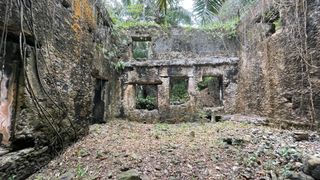ramonmercado
CyberPunk
- Joined
- Aug 19, 2003
- Messages
- 60,955
- Location
- Eblana
Was this the first slave plantation?
Plantation slavery was invented on this tiny African island, according to archaeologists
By Kristina Killgrove published 2 days agoA 16th-century sugar estate on the tiny African island of São Tomé is the earliest known example of plantation slavery.

The island of São Tomé, located in the Gulf of Guinea off the western coast of Africa, served as a major point of connection in the 16th-century European-African slave trade. Here, we see the inside of a building at Praia Melão that researchers excavated. (Image credit: M. Dores Cruz)
Plantation slavery may have originated on a tiny west African island at the equator, according to archaeologists who investigated a 16th-century sugar mill and estate.
São Tomé (Portuguese for "Saint Thomas"), an island 150 miles (240 kilometers) west of Gabon in the Gulf of Guinea, was first settled by the Portuguese in the late 15th century. Finding an uninhabited island with abundant wood, fresh water and the potential for growing sugarcane, the Portuguese monarchy tried to entice people to move there. Due to high rates of malaria, though, São Tomé was thought of as a death trap. By 1495, to supply labor for the sugar trade, the Portuguese rulers forced convicts, Jewish children and enslaved Africans to move to the island.
While other Portuguese sugar mills relied on enslaved people solely for manual labor, in the São Tomé sugar plantation system, enslaved people — largely from what are now Benin, the Republic of the Congo, Angola and the Democratic Republic of the Congo — performed nearly all the tasks, from the harvesting and processing of sugarcane to the carpentry and stone masonry needed to build and run the mills.
Due to lack of research, the historical significance of the island has been mostly overlooked.
This made São Tomé "the first plantation economy in the tropics based on sugar monoculture and slave labour, a model exported to the New World where it developed and expanded," the researchers wrote in a new study, published Monday (Aug. 14) in the journal Antiquity.
Source:
https://www.livescience.com/archaeo...ny-african-island-according-to-archaeologists

